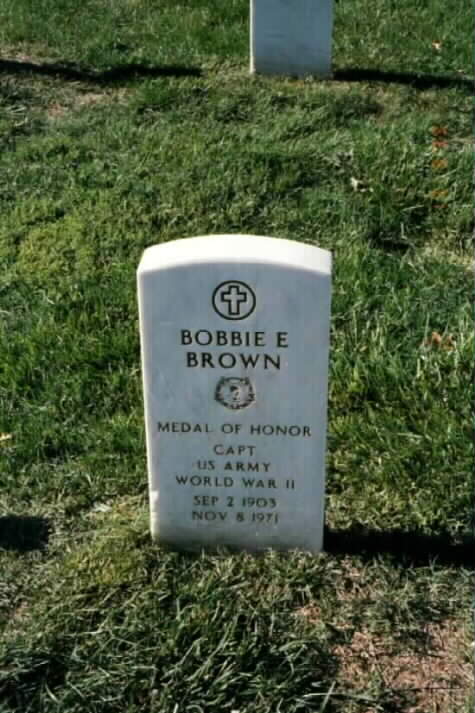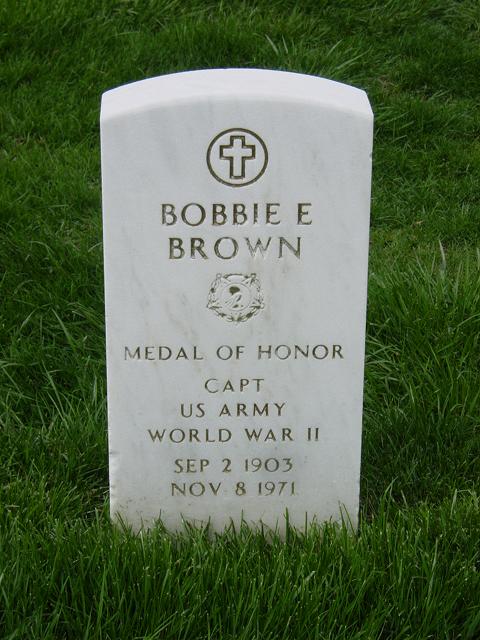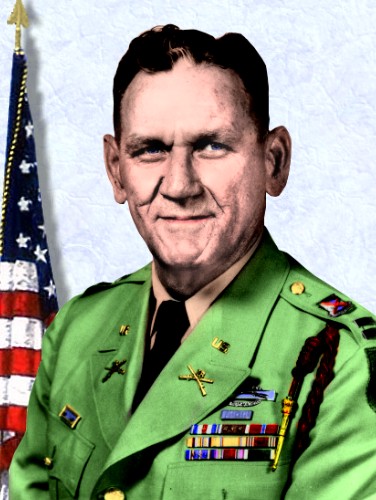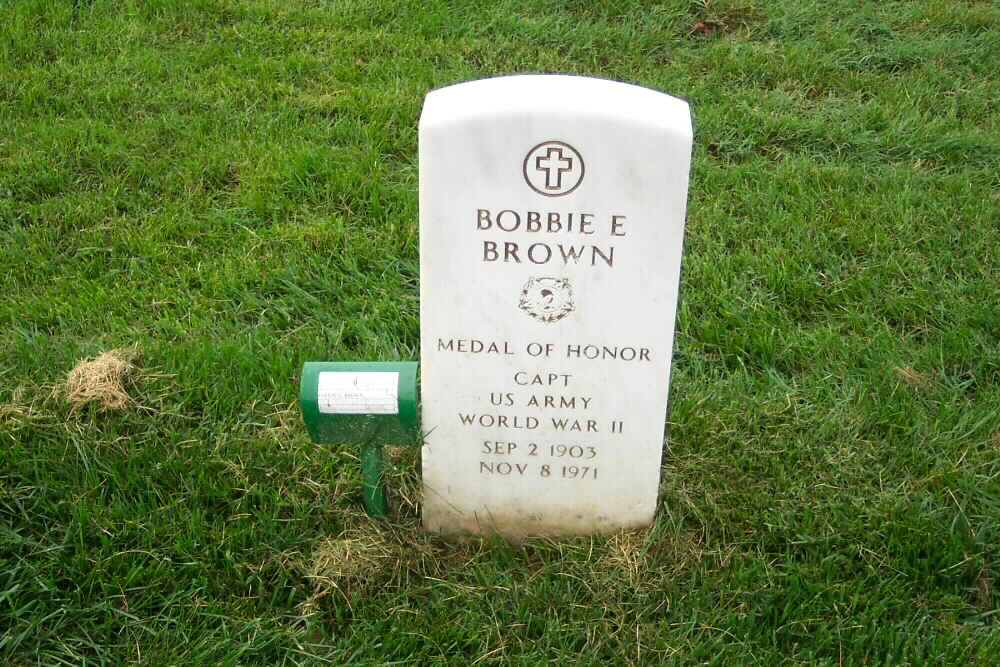Medal of Honor. Organization: Company C, 18th Infantry, 1st Infantry Division. Place-Date: Crucifix Hill-Aachen, Germany 8 October 1944. Entered service Columbus, Georgia. Born: Cresview, Florida. GO 74, 1 September 1945.
September 2, 1903-November 8, 1971.
Commander of Co C, he was a craggy-faced 6-footer who, at age 37, already had 22 years in army. Born in Dublin, Georgia, in 1907, Robert Evan Brown, Jr left home in 1922. There were just too many mouths to feed and not enough money coming in. At the army recruiter’s in Columbus, he told the Sergeant he was 18. The Army badly needed bodies in 1922, and he was big for his age. He was accepted. Because he filled out his first enlistment papers with his nickname “Bobbie,” that’s how the army knew him for next 3 decades.
Instantly found a home in army. Every aspect of military life appealed to him. He felt more motivated than he ever had before. “I always wanted to be tops in whatever I did,” he once said. And he was. He qualified as an expert with every weapon in army’s arsenal. He took up boxing and football, too. He scored 38 victories in the ring. On the gridiron he made all-army team in 1927. Three universities offered him scholarships to play football for them, then they learned he’d only completed 7th grade. But that didn’t matter to the army.
By the time World War II began, he was the first Sergeant in the Headquarters Company of Patton’s 2nd Armored Division. After fighting across North Africa, he received battlefield promotion to Second Lieutenant and transferred to the 1st Infantry Division. He led a platoon of Company C up Omaha Beach on D-Day. In fighting across France, his Company Commander was killed. He assumed command.
A few days later the promotion became official. At 4 am, October 8, 1944, he received orders for an attack on Crucifix Hill. Of 43 known pillboxes and bunkers, his company was responsible for numbers 17, 18, 19, 20, 26, 29, and 30. After a flight of P-47 Thunderbolts finished an air strike at 1:15 pm, he led his company out of positions in a graveyard at foot of the hill. They made it about 150 yards to an antitank ditch in front of pillbox 18 before heavy German fire forced them to seek cover. He turned to his platoon Sergeant, “Get me a couple of flamethrowers, some pole and satchel charges.” Once armed with those, he had his riflemen lay down a base of fire. Then he started crawling alone toward the pillbox. A bomb had blown a big crater alongside the pillbox. He jumped into it and prepared to drop a satchel charge through an aperture by a door. While he worked, a German soldier suddenly stepped out of door. He instantly leaped forward and struck the man in the face with roundhouse punch. The young soldier dropped limply inside the door. He hurled in a satchel charge, slammed the steel door shut, then dove headfirst back into crater. The pillbox erupted, huge clouds of smoke illowing from its rifle ports. One down.
He wriggled his way back to his men, picked up some more charges, then went back uphill 35 yards past the still smoking bunker and toward number 19. Machine-gun bullets zipped past within inches of his head. Several mortar rounds crashed nearby, slamming his body to ground. Under his company’s covering fire he pushed forward. Snaking behind the concrete structure, he shoved a pole charge through a 12-inch opening. That blew a gaping hole in pillbox. For good measure, he tossed a satchel charge. That took care of any survivors. On his way back downhill for more charges, he noticed blood covering one knee. Then his Sergeant told him, “Sir, there’s bullet holes in your canteen.” He had no idea when he’d been hit.
Pillbox 20 was largest and most heavily armed fortification on the hill. A turret, mounting a cut-down 88-mm, revolved 360 degrees on top. Walls were 6-feet of concrete. No less than 6 machineguns poked their barrels through firing ports. Later it would be learned that 45 Germans manned the structure. He had no idea how he’d knock it out, but he’d try. He followed a communications trench 20 yards from number 19 to 20. He studied the apertures, trying to decide which one to stuff a pole charge in, when nearby movements caught his eye. A German soldier was entering bunker via a steel door, his arms filled with ammunition. As the German disappeared through the door, he acted. He lunged forward, pulled door open, threw in 2 satchel charges, and dove for cover. Just as he landed on his face, the pillbox erupted. With the destruction of pillbox 20, enemy resistance on Crucifix Hill crumbled. All that remained was mopping up. His assault has secured the 1st Division’s flank.
He was wounded during the street fighting in Aachen when an artillery shell landed practically beside him. Numb, blood streaming from his nose, ears, and mouth, he headed for an aid station. He spent several months in a hospital in Belgium, then went home on 30-day leave. He rejoined Company C in Germany and fought with it into Czechoslovakia. After the war ended, he flew home to receive his Medal of Honor, August 23, 1945.
The next 2 years were spent in and out of hospitals, as army doctors tried to repair damage done by 13 war wounds. He finished his 30 years of service to his country in 1952. Besides the Medal of Honor he also held 2 Silver Stars and the Bronze Star.
Like many men who have faced the full horrors of war, he was plagued by painful memories of his wartime experiences. Unable to find decent civilian job, ended up as a janitor at the United States Military Academy at West Point, New York. Continually bothered by the horrible memories of war, and in constant pain from injuries, took his own life, November 12, 1971. He now lies at rest in Section 46 of Arlington National Cemetery, not far from the Tomb of the Unknowns and the Memorial Amphitheater.
BROWN, BOBBIE E.
Rank and organization: Captain, U S. Army, Company C, 18th Infantry, 1st Infantry Division. Place and date: Crucifix Hill, Aachen, Germany, 8 October 1944. Entered service at: Atlanta, Georgia. Born: 2 September 1903, Dublin, Georgia. G.O. No.: 74, 1 September 1945.
Citation:
He commanded Company C, 18th Infantry Regiment, on 8 October 1944, when it, with the Ranger Platoon of the 1st Battalion, attacked Crucifix Hill, a key point in the enemy’s defense of Aachen, Germany.
As the leading rifle platoon assaulted the first of many pillboxes studding the rising ground, heavy fire from a flanking emplacement raked it. An intense artillery barrage fell on the American troops which had been pinned down in an exposed position. Seeing that the pillboxes must be neutralized to prevent the slaughter of his men, Capt. Brown obtained a pole charge and started forward alone toward the first pillbox, about 100 yards away. Hugging the ground while enemy bullets whipped around him, he crawled and then ran toward the aperture of the fortification, rammed his explosive inside and jumped back as the pillbox and its occupants were blown up. He rejoined the assault platoon, secured another pole charge, and led the way toward the next pillbox under continuous artillery mortar, automatic, and small-arms fire. He again ran forward and placed his charge in the enemy fortification, knocking it out. He then found that fire from a third pillbox was pinning down his company; so he returned to his men, secured another charge, and began to creep and crawl toward the hostile emplacement.
With heroic bravery he disregarded opposing fire and worked ahead in the face of bullets streaming from the pillbox. Finally reaching his objective, he stood up and inserted his explosive, silencing the enemy. He was wounded by a mortar shell but refused medical attention and, despite heavy hostile fire, moved swiftly among his troops exhorting and instructing them in subduing powerful opposition. Later, realizing the need for information of enemy activity beyond the hill, Capt. Brown went out alone to reconnoiter. He observed possible routes of enemy approach and several times deliberately drew enemy fire to locate gun emplacements. Twice more, on this self-imposed mission, he was wounded; but he succeeded in securing information which led to the destruction of several enemy guns and enabled his company to throw back 2 powerful counterattacks with heavy losses.
Only when Company C’s position was completely secure did he permit treatment of his 3 wounds. By his indomitable courage, fearless leadership, and outstanding skill as a soldier, Capt. Brown contributed in great measure to the taking of Crucifix Hill, a vital link in the American line encircling Aachen.
BOBBIE E. BROWN, MEDAL OF HONOR WINNER
WEST POINT, New York, November 11, 1971 – Bobbie E. Brown, who won the Medal of Honor in World War II and held eight Purple Hearts and who was employed as a foreman in the custodial department at the United States Military Academy, died Monday at his Highland Falls, New York, home near here, of a self-inflicted gunshot wound in the chest. He was 68 years old and was said to have been in failing health.
Mr. Brown, a rough-hewn Southerner who had been born in poverty, had been an enlisted man for more than twenty years when he won a battlefield commission in World War II. He was a Captain in command of the 18th Infantry Regiment’s “Charlie” Company when he performed the exploits that were to win him the Medal of Honor.
The night was October 8, 1944. The place was Aachen, Germany, where the First Infantry Division – the Big Red One – was spearheading the drive into the enemy’s own territory. Withering fire had the men of C Company pinned down.
Three times Captain Brown charged the German lines, and despite drawing heavy barrages of fire he managed to silence enemy pillboxes with parcels of dynamite. The official Army commendation states:
“Although wounded by mortar fire he went forward and deliberately drew enemy fire in order to locate gun emplacements. He was wounded twice more but succeeded in securing information which led to the destruction of several enemy guns and enabled his company to throw back two powerful counterattacks with heavy losses to the enemy.”
Mr. Brown, who held the rank of Captain at his discharge, was one of 28 veterans of the European and Pacific theaters who received the Medal of Honor from President Harry Truman on August 23, 1956, in what was described as the time as the largest White House mass decoration ceremony on record.
In Huntsville, Alabama, yesterday, Lieutenant General Robert H. York, who had been Mr. Brown’s commanding officer called him “absolutely fearless.”
General York recalled that an Army report on Mr. Brown said that he had the “educational equal vent of 12-year-old” and that he “hadn’t completed one year of schooling.”
Nevertheless, General York said, Mr. Brown, who had been a platoon sergeant before he won the battlefield commission, had demonstrated outstanding ability at organizing and planning.
“He was a scrapper and his men had,” the General said, “confidence in him and would go anywhere with him.”
General York said that one of his company commanders was hit in Normandy; he had to select a new one. He continued:
“I finally made one of the toughest decisions of my life. I decided to give the company to Bobbie in spite of his limitations. Shortly after I recommended him for the promotion I was transferred out to take charge of a regiment in the 83rd Division. I worried from time to time whether I’d made the right choice. I did.”
Retired from the Army in 1950 after 28 years of service, Mr. Brown was employed by the Military Academy as a waiter in the mess hall and later he became foreman in the custodial department.
Burial space at Arlington National Cemetery has become sparse, but because he was a Medal of Honor winner, Bobbie Brown will be buried there tomorrow.
BROWN, BOBBIE EVANS
- CAPT US ARMY
- VETERAN SERVICE DATES: 06/19/1943 – 04/01/1950
- DATE OF BIRTH: 09/02/1903
- DATE OF DEATH: 11/08/1971
- DATE OF INTERMENT: 11/12/1971
- BURIED AT: SECTION 46 SITE 1021-17
- ARLINGTON NATIONAL CEMETERY


Michael Robert Patterson was born in Arlington and is the son of a former officer of the US Army. So it was no wonder that sooner or later his interests drew him to American history and especially to American military history. Many of his articles can be found on renowned portals like the New York Times, Washingtonpost or Wikipedia.
Reviewed by: Michael Howard


